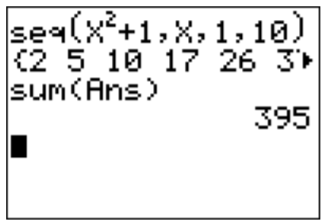26.7: A.7- Funciones especiales (valor absoluto, enésima raíz, etc.)
- Page ID
- 117836
Ahora señalamos algunas funciones importantes en el menú MATH (\(\boxed{\text{math}}\)) y en el menú LIST (\(\boxed{\text{2nd}}\)\(\boxed{\text{stat}}\)), que se utilizan en este curso.
Fracciones
Supongamos que en la pantalla principal evalúas\(4/6\). Su calculadora se mostrará\(.66666666667\). Si quisieras ver esto como una fracción escribirías\(\boxed{\text{math}}\)\(\boxed{\text{enter}}\)\(\boxed{\text{enter}}\). Ahora verá que\(2/3\) se muestra.
Valor absoluto
Para evaluar\(|-4|\) escribirías en la pantalla principal\(\boxed{\text{math}}\)\(\boxed{\triangleright}\)\(\boxed{\text{enter}}\)\(\boxed{\text{(-)}}\)\(\boxed{\text{4}}\)\(\boxed{\text{enter}}\). Se\(4\) debe mostrar la respuesta. Para graficar\(|x-2|\), vaya a la pantalla Y= (\(\boxed{y=}\)) e ingrese en el espacio Y1 (por ejemplo)\(\boxed{\text{math}}\)\(\boxed{\triangleright}\)\(\boxed{\text{enter}}\)\(\boxed{\text{X,T,}\theta,n}\)\(\boxed{\text{-}}\)\(\boxed{\text{2}}\)\(\boxed{\triangleright}\)\(\boxed{\text{enter}}\).
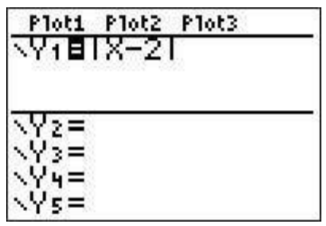
Ahora puedes ir a la pantalla gráfica para ver la gráfica.
\(n\)-ésima raíz
Para calcular la raíz cubo de\(8\). Presione en la pantalla principal\(\boxed{\text{3}}\)\(\boxed{\text{math}}\)\(\boxed{\text{5}}\) (o seleccione la raíz x)\(\boxed{\text{8}}\)\(\boxed{\text{enter}}\).
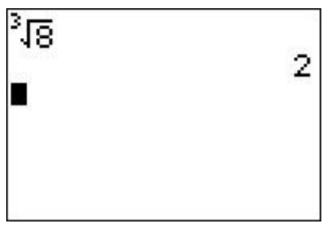
Puede calcular cualquier raíz de esta manera (por ejemplo, la raíz\(5\) th de\(7\)). Para la raíz cubo también se puede utilizar\(\boxed{\text{math}}\)\(\boxed{\text{4}}\) en su lugar. Recordemos también la definición algebraica de la raíz\(n\) th,
\[\sqrt[n]{x}=x^{\frac{1}{n}} \nonumber \]
para que la raíz\(5\) th de también se\(7\) pueda calcular presionando\(\boxed{\text{7}}\)\(\boxed{\wedge}\)\(\boxed{\text{(}}\)\(\boxed{\text{1}}\)\(\boxed{\div}\)\(\boxed{\text{5}}\)\(\boxed{\text{)}}\).
Factoriales
Para calcular\(5!\), por ejemplo, en la pantalla principal escriba\(\boxed{\text{5}}\)\(\boxed{\text{math}}\) luego mover el cursor hacia la derecha tres veces (o una vez a la izquierda) para que se muestre el menú 'PRB'. La opción 4 es '\(!\)' así que presiona\(\boxed{\text{4}}\) o mueve el cursor para resaltar esta opción y presiona\(\boxed{\text{enter}}\). Finalmente presione\(\boxed{\text{enter}}\) y\(120\) se mostrará la respuesta.
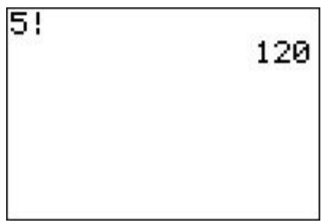
Combinaciones y permutaciones
Para calcular\(_{5} C_{2}=\dbinom{5}{2}\), en el tipo de menú principal\(\boxed{\text{5}}\). Después vaya al menú de probabilidad matemática presionando\(\boxed{\text{math}}\) luego la flecha derecha (o izquierda) hasta que se resalte 'PRB'. Verás que la tercera opción es\(_nC_r\) tan presionada\(\boxed{\text{3}}\). Esto te devolverá a la pantalla principal. Prensa\(\boxed{\text{2}}\)\(\boxed{\text{enter}}\). Se\(10\) mostrará la respuesta.
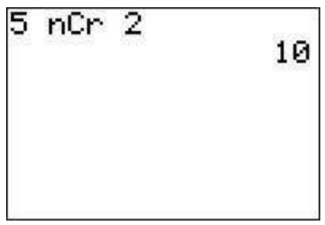
Las permutaciones\(_nP_r\) se manejan de la misma manera excepto que es la segunda opción bajo el menú matemática-probabilidad en lugar de la tercera.
Secuencias y series
Una secuencia\(a_1,a_2,a_3,\dots\) que viene dada por una fórmula se puede agregar a través del menú 'LISTA' (presione\(\boxed{\text{2nd}}\)\(\boxed{\text{stat}}\)). Por ejemplo, para ingresar los primeros\(10\) términos\(a_1,a_2,\dots, a_{10}\) de la secuencia\(a_n=n^2+1\), tenemos que escribir\(seq(x^2+1,x,1,10)\). Aquí, el comando 'sequence' toma cuatro entradas, primero la asignación\(x^2+1\), segundo la variable independiente\(x\), tercero el índice\(1\) inicial y cuarto el índice final\(10\). Esta expresión se ingresa a la calculadora presionando\(\boxed{\text{2nd}}\)\(\boxed{\text{stat}}\)\(\boxed{\triangleright}\)\(\boxed{\text{5}}\)\(\boxed{\text{X,T,}\theta,n}\)\(\boxed{x^2}\)\(\boxed{\text{+}}\)\(\boxed{\text{1}}\)\(\boxed{\text{,}}\)\(\boxed{\text{X,T,}\theta,n}\)\(\boxed{\text{,}}\)\(\boxed{\text{1}}\)\(\boxed{\text{,}}\)\(\boxed{\text{1}}\)\(\boxed{\text{0}}\)\(\boxed{\text{)}}\) y luego se confirma presionando\(\boxed{\text{enter}}\). Obtenemos:
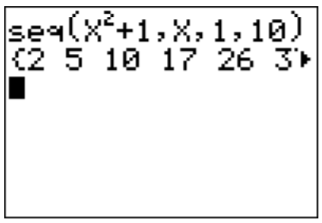
Para agregar los diez números\(a_1+\dots +a_{10}\) de la secuencia, utilizamos el comando 'sum' en el menú LIST-MATH. Presione\(\boxed{\text{2nd}}\)\(\boxed{\text{stat}}\)\(\boxed{\triangleleft}\)\(\boxed{\text{5}}\) para ingresar la expresión\(sum(\) ''. Luego usando la respuesta previamente ingresada presionando\(\boxed{\text{2nd}}\)\(\boxed{\text{(-)}}\), y terminando con\(\boxed{\text{)}}\)\(\boxed{\text{enter}}\), ahora calculamos la suma deseada.
